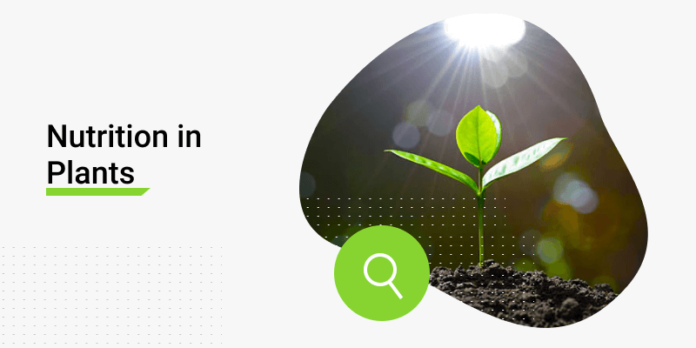Welcome to class 7. A new journey of adventure will begin. Today you will understand the chapter Nutrition in Plants. Have you ever wondered why your parents always force you to eat healthy food even though they taste so bad? Those spinach, milk, fish, etc have something really special that you require for healthy development. Those special things are called nutrients. Some examples are proteins, carbohydrates, vitamins, etc.
Think: Why can’t our body produce them if they are so essential?
Let us take a moment to understand nutrition. It means the complete process by which an organism takes in food and utilizes it for various purposes like growth.
Although our bodies cannot prepare them, there is someone who can prepare their food. Preparing your food does not mean cooking. In scientific terms, we mean that the organism is capable of producing food directly by using raw materials from the surrounding.
Plants can prepare their food using carbon dioxide from air, sunlight, water, and minerals from the soil. By using this raw materials, plants produce glucose. This mode of nutrition is called autotrophic nutrition.
Some might argue here that a cow is also autotrophic as it takes in plants and produces milk. This is false because we tend to ignore the meaning of raw material in the definition. Raw material here refers to the non-living organism. In the case of the cow, a cow takes in plants, which is living organism. Hence cow is not autotrophic.
But what makes plants so special that they can produce their food?
Plants have got a really interesting cell structure. Let’s discuss them one by one. Stomata are small openings in the leaves mostly located at the bottom of the leaf that allow the exchange of carbon dioxide. The stomata are surrounded by guard cells, that shrink and expand to regulate the opening. They are way too small to be visible to the naked eye.
The roots and well-developed transportation system in plants allow the transfer of water and minerals. The roots take in water from the soil by the same phenomenon due to which your finger wrinkle while you keep your hand in the water for a prolonged period. The water is then transported to different parts by a well-developed transportation system that involves pipe-like structures.
Have you ever noticed that some parts of plants are green in colour? This is due to the presence of a green pigment called Chlorophyll.
Think: But why are the pigment green?
The function of this pigment is simple. It simply takes in the energy of sunlight and stores it. This energy is then used to synthesis glucose from carbon dioxide and water. This process is of synthesizing food using carbon dioxide and water in presence of chlorophyll is called photosynthesis. During this process, the plants release oxygen. This is the reason why you should plant trees.
Wonder how our lifestyle would have changed if we could have produced food like plants.
Glucose is a form of carbohydrate. Carbohydrates can further be converted into fats. Now, how are proteins produced? Proteins can also be derived from it but they require one extra thing that is Nitrogen the same gas that is put in the chips packet. Nitrogen is abundant in nature but still, plants can directly use them like they use carbon dioxide. Here lightning and bacteria come to rescue who fix nitrogen to nitrogenous products which are then used by plants. These nitrogenous products are similar to the fertilizer used by farmers.
But there are plants too that can’t prepare their food. Few plants don’t have chlorophyll like Cuscuta, so for nutrients, they snatch their food from other plants. This is called parasitic nutrition. Apart from this, some plants feed on animals called insectivorous plants. They feed on insects for nitrogen.
What about those who can’t prepare their food? They are called heterotrophic organisms.
Some interesting heterotrophic modes of nutrition are-
1) Parasitic nutrition- In this an organism(parasite) feeds from another organism(host). The parasite takes all the nutrients from the host and returns nothing to the host. Thus they are dangerous.
2)Saprotrophic nutrition- In this organisms derive their nutrients from dead and decaying matter. They are so important as they are the reason why biodegradable things decompose. A famous example is fungi. This includes mushrooms too.
3) Symbiotic nutrition- This is similar to a contract. In this, the organisms share food and shelter. This seems to be friendly nutrition. Example- Lichens, chlorophyll-containing algae, and fungi undergo symbiosis. Lichen provides the fungus with food and the fungi shelters the lichen.
Let us talk about a process that is pretty common in the paddy fields. Have you ever wondered why the farmers need to use fertilizer in the first place? The reason is that for photosynthesis plants absorb a lot of minerals and nutrients from the soil due to which the nutrients deplete in the soil. So nature must do something to make a balance it. Here a bacterium called rhizobium helps in converting the nitrogen that is present in the air to other nitrogenous products like urea. As plants can’t directly use the minerals from the air so they require them in other forms.
Unfortunately, Rhizobium cannot make their food so they need to depend on someone to feed them. Hence primarily Rhizobium has a symbiotic relation with gram and pea plants. The bacteria are attached to the roots of the plant. Thus, rhizobium can significantly help in increasing the yield of leguminous plants by providing them with a continuous supply of nitrogen. This is also important for us as consuming grams, peas, etc helps in the growth and development of the body as well as mind as they contain a lot of proteins. That’s the happy ending story of rhizobium.
While going through the summary, students are advised to try to rethink the questions. They should polish their curiosity and try to explore every new word that they have encountered while reading it. Learn more using the resources available to you.








